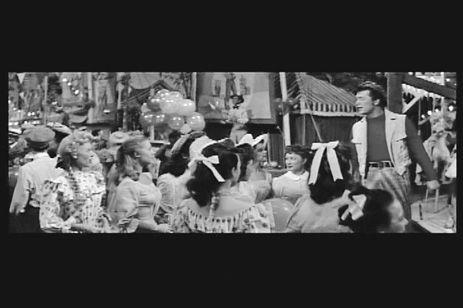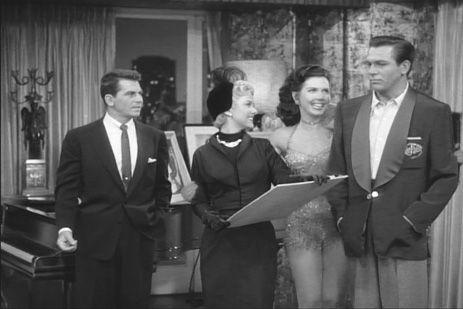Enchanted Evenings:The Broadway Musical from 'Show Boat' to Sondheim and Lloyd Webber (64 page)
Read Enchanted Evenings:The Broadway Musical from 'Show Boat' to Sondheim and Lloyd Webber Online
Authors: Geoffrey Block

Despite their commercial successes (the exception here is
Carousel
), the film versions of the musicals treated in act II have generated controversies over their artistic success as adaptations. Critics have taken issue with their direction, scenic design, and cinematography, and perhaps most vociferously over casting issues and the pros and cons of vocal dubbing. Two of the films,
Carousel
and
Kiss Me, Kate
, feature mainly singers.
Guys and Dolls
combines singers and non-singers but even the latter sang for themselves. In contrast, most of the principals in the
My Fair Lady
and
West Side Story
adaptations are dubbed by professional singers. Even Rita Moreno, herself an accomplished professional singer and recording artist, had her voice replaced.
1
Less obvious but arguably even more radical aspects of sonic technological change—orchestral augmentations, selective mixing via multiple-track recording, combining alternate takes via editing, the effects of microphone placement—have slipped past underneath most critics’ notice. For those who have grown accustomed in recent years to the expectation that voices we hear on the soundtrack belong to the faces of those we see in the picture (e.g.,
Chicago, Dreamgirls, Hairspray, Rent, The Phantom of the Opera
, and
Sweeney Todd
), the knowledge that Marni Nixon is the voice of Audrey Hepburn
and
Natalie Wood might be disconcerting. These musical adaptations may come across today as faithful to their theatrical origins to the point of being labored and unfaithful to their new medium. At the same time they allow us to imagine their stage counterparts and for the most part will satisfactorily see us through until something better comes along, such as a new Broadway revival or a community theater or high school production.
(1956)
Not long after the release of
Oklahoma!
in October 1955,
The King and I
and
Carousel
followed in quick succession in February and March of the next year. Unlike the popular successes of
Oklahoma!
and
The King and I
, the third Rodgers and Hammerstein film adaptation to appear within six months,
Carousel
failed at the box office in its own time and has not enjoyed much critical approbation in the decades since its debut—even though it brought back from
Oklahoma!
the winning partnership of Gordon MacRae and Shirley Jones. Although spared the acrimony heaved at Joshua Logan and those disturbing colored filters he will always be blamed for in the next 20th Century-Fox Rodgers and Hammerstein film adaptation,
South Pacific
in 1958—which Gerald Mast found almost unrivaled “for sheer bad taste”—for Mast and many others
Carousel
remains unequivocally “the worst of the lot.”
2

Carousel
, 1956 film. Carrie Pipperidge (Barbara Ruick) and Julie Jordan (Shirley Jones) (foreground left) watch Billy Bigelow (Gordon MacRae) (right) at The carousel.
Only two songs from the stage version were cut, however, “Geraniums in the Winder” (also missing from the original Broadway cast album) and “The Highest Judge of All.” The screenplay also retains much of Hammerstein’s libretto. Nevertheless, Thomas Hischak, who normally demonstrates equanimity in his assessments of film adaptations in
Through the Screen Door
, describes the
Carousel
adaptation, directed by Henry King, as “unfaithful, incompetent, and certainly uninspired” and “the most unsatisfying film treatment of a Rodgers and Hammerstein musical.”
3
For a minority report one can turn to an essay by Bruce Babington and Peter William Evans in which the authors describe the dream ballets of
Carousel
as well as
Oklahoma!
as works in which “the greater surrealist possibilities of the cinema [are]
used to their fullest advantage” and other “ways in which the film is as moving today as when it was made.”
4
One of the many ways in which the staged
Carousel
stands out from conventional musical theater fare is that the main character takes his own life. In
Oklahoma!
the villain (Jud Fry) kills himself accidentally while in the process of trying to kill the male protagonist (Curly), and film audiences who were seeing the Rodgers and Hammerstein shows in their filmed order had also recently witnessed the death of the King of Siam. Despite this sad eventual turn in the plot, perhaps in an effort to prepare younger viewers and those new to the show for Billy’s death and to reassure them that he was still alive on screen, although technically dead, the film opens in heaven fifteen heavenly minutes later (the equivalent of fifteen years on earth) where Billy tells the story of
Carousel
, including his death, as if it were a flashback. For those viewers who might view Billy’s suicide as a sin comparable to his decision to commit a robbery in order to get enough money to support the as yet unborn daughter he imagined in “Soliloquy,” the suicide of the stage version was changed to an accidental death. By the end of the film Billy will take advantage of the opportunity to return to earth in order to rectify some of the emotional damage he inflicted on his daughter, Louise, now fifteen earth years old. At the end of the play he succeeds in comforting his troubled daughter at her high school graduation, and when he does, the strains of “You’ll Never Walk Alone” can move even modern-day cynics to request some tissues.
Even if the film proves disappointing on many levels, it offers the opportunity to get a sense of what audiences saw onstage, including Louise’s dream ballet with choreography pilfered from Agnes de Mille (who had to sue to be properly credited) as well as most of the songs and a large helping of the original stage dialogue. Looking at the scene we focused on in the
Carousel
chapter, we see that much has been retained. It begins about seven minutes into the film, after the first scene in heaven. Some of “The Carousel Waltz” was heard over the credits—significantly shorn of its dissonant and mysterious opening, which will be heard later with new associations—but a more substantial statement of the waltz, starting with the first main waltz after the introduction, occurs in the transformation from Heaven to Earth. Despite a few cuts here and there, most of the waltz returns when the scene shifts to the amusement park. There it supports the pantomimed prologue that tells us so much about how Billy regards Julie as special and how the carousel proprietress Mrs. Mullin jealously senses an undeniable romance in bloom. With a few small additions and deletions, most of the nonunderscored dialogue with Carrie, Julie, Mrs. Mullin, and Billy that opens act I, scene 2, is preserved.
5
All this takes a little over five minutes.
The opening of the Julie and Carrie sequence that precedes “Mr. Snow,” however, with its rhythmic recitative merging into the Julie Jordan tune and the “Mill Theme” is entirely removed from the film.
6
As a result, “Mr. Snow” appears after only thirty seconds of underscored dialogue (a little more than 15 minutes into the film), the conversation in which the stage Carrie assumes her friend now has “a feller of yer [your] own.” Now that Julie has Billy, more an intuitive assumption than a reality at this stage in the relationship, Carrie can sing about her feller. Instead of the Julie Jordan music that underscores this conversation in the stage version, when we hear the “Mill Theme” for the first time in the film, it is impossible to understand its significance. By the end of the brief exchange, however, the underscoring will match the musical phrase indicated in the score (this is the musical passage of dotted rhythms and leaps in the deleted sequence illustrated in
chapter 9
), but now employed with equal meaninglessness. As a result of these liberties, the proof substantiating Carrie’s presumption that Julie has a feller, so clearly explained in their musical exchange onstage but now deleted, creates an abrupt and less convincing transition to Carrie’s song about her feller, “Mr. Snow.”
Billy’s long “Soliloquy” appears boldly without cuts and lasts nearly eight minutes, and earlier “June Is Bustin’ Out All Over” continues with an elaborate and athletic dance of New Englanders that lasts nearly six minutes.
7
On the other hand, portions of “A Real Nice Clambake” and “When the Children Are Asleep,” including their verses, were cut, and the latter is placed considerably later than in the stage version. In its new context, this song now takes place on a boat Carrie and Mr. Snow are sharing with Julie and Billy on the way to the clambake. Since they are now overheard by the more troubled partners, the contrast between Julie and Billy’s turbulent relationship and the more placid one of Carrie and Enoch is more pronounced. In another departure, the distinctive dissonant chords that open the stage show were removed from the opening film credits and opening of the “Carousel Waltz.” They return, however, in the film with a new meaning on two occasions to underscore the darker menacing presence of Mrs. Mullin a few minutes before the “Soliloquy” and again shortly after Billy’s death, and a third time to announce the carnival troupe during Louise’s ballet.
In the end, the mixture of fantasy and realism that worked so well onstage fails to persuade. Mast, the film critic who pronounced this Rodgers and Hammerstein adaptation “the worst of the lot,” finds fault with nearly every aspect but saves his sharpest comments for the director: “Henry King’s direction captures a styleless visual void—from a
papier maché
forest beside a backlot … to a tacky electric-blue heaven strung with plastic Stars of Bethlehem; to a real beach where a soliloquizing Billy wanders in thought (but never picks up a pebble, sifts some sand, or touches a rock).”
8
It is possible that the musical film
Carousel
has negatively prejudiced many viewers against the show. In any event, of all the films from the Rodgers and Hammerstein era,
Carousel
is perhaps most in need of a film remake. This might happen. In 2006, an article in FirstShowing.net announced that the popular Australian movie and stage actor Hugh Jackman, who successfully portrayed Curly in the film adaptation of Trevor Nunn’s London stage revival of
Oklahoma!
, had acquired the rights for
Carousel
and is looking for a director and a screenwriter.
9
Once everyone recovers from the financial debacle of Baz Luhrmann’s
Australia
(2008), Jackman’s most recent star vehicle, it may be time to welcome a new turn on the carousel.
(1953)
In the light of its MGM predecessors
On the Town
, which butchered Bernstein’s great 1944 score in its screen version of 1949, and the remake of
Show Boat
in 1951, which cut many songs and played havoc with both the script and spirit of its original, the film adaptation of
Kiss Me, Kate
, directed by
Show Boat
alumnus George Sidney and starring
Show Boat
film alumni Kathryn Grayson and Howard Keel, was remarkably faithful. By later standards, however, the film adaptation has a long way to go in terms of fidelity to its increasingly respected source, the Broadway version. Sidney begins by taking a major structural liberty in his decision to open the film in Fred’s apartment a month or so earlier than the first rehearsal rather than beginning with the stage show’s opening rehearsal number, “Another Opnin,’ Another Show.” In addition to “Another Opnin,’” another song gone from the film was “Bianca,” which Porter wrote for the character Bill Calhoun under duress when the actor who played him, Harold Lang, insisted he was contractually entitled to a song. In the chapter on
Kiss Me
, Kate (
chapter 10
), we noted Porter’s erroneous belief that the song’s banality would preclude its use.

Kiss Me, Kate
, 1953 film. Cole Porter (Ron Randell), Lilli Vanessi (Kathryn Grayson), Lois Lane (Ann Miller), and Fred Graham (Howard Keel) in Fred’s apartment after a run-through of “So In Love.”
